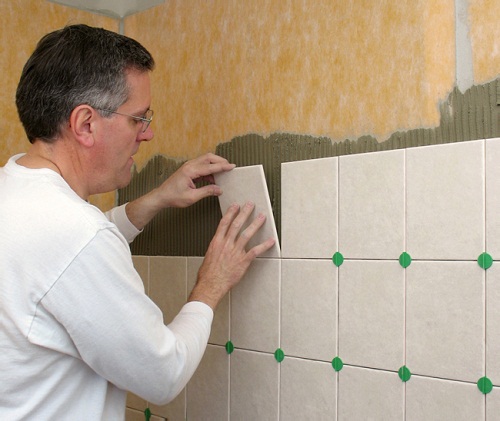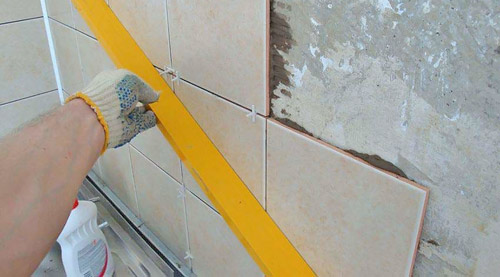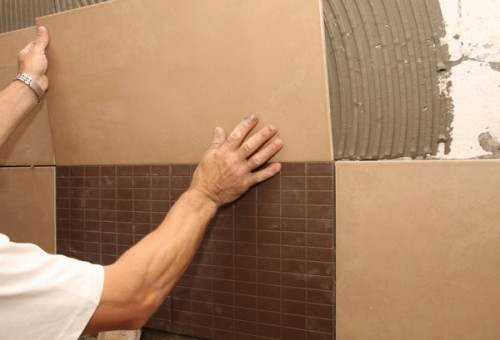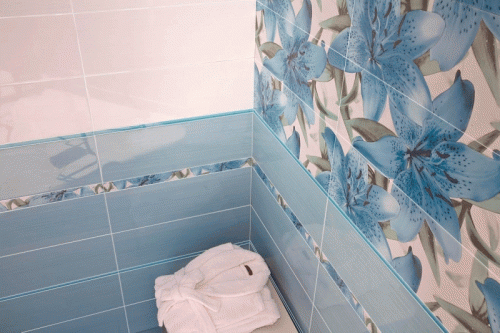The use of tiles in the arrangement of the house is a serious step towards the transformation of the home. Despite all the negative aspects of the material, the tile also has undeniable advantages, without which modern decoration cannot be represented. It is also worth understanding that some materials simply are not suitable in essence to one or another room. A couple of decades ago, ceramic tiles were almost the only finishing material, but now everything has changed.
Content
At that time, this material was extremely simple and universal. Modern manufacturers represent a huge range of tiles, which can be selected by color, pattern and even shape.
It is not so easy to make tiles on a brick or wooden wall yourself. So that as a result, we have a high -quality surface that will last as long as possible, we need to build on some rules and tips.
Prepare the wall surface for laying tiles
Of course, laying tiles on the wall begins with the preparation of the surface. Many consider this the most difficult stage, because the smoothness of the surface and the general durability of the finishing layer depends on it.
In order for the process to be as simple as possible, it is necessary to remove all the plumbing and other objects that prevent finishing work. If tiles are already present on the surface of the wall, it is necessary to take a chisel and a hammer and repel all the old material. This process is quite traumatic, because the acute parts of the tiles often fly away from the wall. At a minimum, you should wear glasses that will protect your eyes. It is also advisable to use gloves and closed work clothes.
After successful removal of the old tile, it will also be necessary to remove the entire old glue. This process is carried out using a hammer and chisel. This is to understand that the glue layer can be too firm, so approaching this process is necessary as careful as possible.
Now one of the most critical stages comes. During it, the surface of the wall should be made as flat as possible, otherwise in the final result we will get a terrible wall in its external qualities. Fortunately, this process is quite simple, so even newcomers in construction should cope with it. The plaster should also be durable. For verification, you can draw a finger along it. If it sprinkles, it is definitely worth picking up a hammer and chisel again, and start removing this layer up to brickwork. In the event that the integrity of the plaster does not cause any questions, it is definitely worth it to proceed to the next stage - to check the geometric surface parameters. For this process, we need a special weight and a rope, on which the first element clings. Using such an elementary object, you can establish how even the wall. The rope closes with the weight to the upper point of the wall.
It is also necessary to check the angles for determining the necessary values. The square must indicate everywhere that the angle of the wall is 90 degrees. Otherwise, plastering must be carried out. It should be understood that the required value of the angle of walls is an incredibly important factor. This can be especially felt if a washing machine or bathroom is installed in one or another angle. Definitely, these objects will immediately focus on the fact that the wall is really a curve.
Already using a water level, it is necessary to check the surface of the walls on bulges and other negative features. Of course, here it is also possible to apply a rope with a weight that was mentioned a little earlier, but it should be clearly understood that the water level indicates even the most insignificant defects in the wall, which is very important.
Laying tiles to the floor surface, like walls, is practically no different. It is really important that in this process a level is applied, which will ensure impeccable smoothness of the surface.
Important steps for arranging the wall before laying tiles
Obviously, the alignment of the walls begins further. For this we need some tools:
- drill and construction mixer, which are necessary for the batch of the mixture;
- capacities of various sizes for making a comb (plastic buckets);
- grater and trowel for the process of applying cement mortar;
- water level for analysis of surface evenness;
- spatulas that will be needed for applying certain building mixtures.
First of all, the technology of laying tiles on the wall begins with the application to the surface of the cement mortar. This is done, first of all, for leveling the wall. It is necessary to pour the solution with a trowel. For uniform application of the material, a grater is used to the surface. It is definitely important to check the final result of the application, which is carried out using a water level. Too thick layer of solution is not the best option. You should try to make it as thin as possible, but not to the detriment of the geometric indicators of the surface.
The alignment of massive surfaces is carried out using plaster. For the optimal result, you should use special beacons. They must be attached vertically. Obviously, with a flat wall, they will look as harmonious as possible. A device called the rule will help to simply remove excess finishing material. You should know that the beacons have various profiles. In the event that the surface has small flaws in terms of hollow, it is necessary to use a larger profile.
The number of slats can be unlimited, but it makes sense to equip them at a fixed distance, but so that this does not damage evenness. Lighthouses are mounted on alabaster. A small problem occurs when cement dries for a long time. At any time, lighthouses can simply collapse. In this case, experts advise using alabaster at several points of the bar.
Also, special metal profiles will need to be equipped at the corners. Without them, it will be almost impossible to achieve a perfectly even angle (90 degrees). In several places of profiles, nails are driven and pulled with cords. It is worth checking the strength of the structure so that in the future, under the pressure of the tiles there is no collapse. When the solution applied to the profiles hardens, it is necessary to remove nails and cords. Next, the final plastering begins. The plaster is produced by the up-up-down movements. To achieve the maximum flat surface of the wall, it should be plastered, starting from the location of the lighthouses.
Features of choosing ceramic tiles
Laying tiles on the wall of the kitchen or any other room is primarily based on the material itself. It is definitely important to choose precisely high -quality tiles, which, in all its properties, would meet the requirements. First of all, we need to measure the walls that need to be covered with tiles. When visiting a construction store, you should distinguish the tiles for the floor and for the wall. At first glance, they have no special differences, but the flooring tile has additional strength, which the walls are useless. Also, the surface of the floor tile has a certain roughness that contributes to comfortable movement.
Next, you need to pay attention to the variety of tiles. Often the 1st, 2nd and 3rd grades of the material can be distinguished by eye. For example, the 3rd grade of tiles looks quite modest and is used in cases where it is necessary to save on the construction process. The main difference between the existing classes of tiles is their caliber. More precisely, this is their standardization. A fairly serious tile production technology has its drawbacks. First of all, this applies to the size of the material. During the responsible construction work, the tile should correspond to the regulated sizes and parameters as much as possible. The 2nd and 3rd classes do not always have the necessary sizes, but the deviations are still minimal.
In order not to get into an unpleasant situation, you should take a little more tiles than necessary. This is obvious, because during the masonry process, anything can happen. The material can simply crack along the road, or break during the laying process. There is also a possibility that the necessary volumes of tiles are simply incorrectly calculated. Several spare units of the material can save the situation even after a few years, when one of the tiles cracks. The assortment of facing material changes quite often, so after a couple of years to find a similar coloring of the material will be difficult.
Also, when laying tiles on the wall, we need a high -quality dry construction mixture. Obviously, any products have their own purpose. If you are engaged in laying tiles on a brick wall in the bathroom, you should look at mixtures for wet rooms. If tile laying occurs on the outer walls of the dwelling, it is necessary to evaluate the parameters of the frost resistance of the construction mixture. It is also very important to pay attention to the maximum allowable thickness of the layer, which must be indicated on the packaging of the material.
The process of laying tiles to the surface of the wall
Before starting the tile laying process, we need to prepare adhesive material. In small portions, glue should be added to the container with water. At the same time, it is necessary to stir the composition. Large volumes of the material should be stirred using a drill or a construction mixer. If you fall asleep the entire volume of the mixture into the water, then it will be extremely difficult to mix the tool, this should be taken into account. Ultimately, the mixture should not be too liquid and too thick.
The laying of tiles from the lower row begins. In order for each row to be as smooth as possible, it is necessary to use a wooden rail, which could be applied to the upper part of the material and chopped. It is also necessary to use corner rails. They will be required after laying the first row of tiles. At the level of the top point of the tile of the first row, we drive nails into the rails. Accordingly, we carry out a thread between the corners, which will indicate to us even the slightest layout errors.
Apply an adhesive mixture to the tile to a gear spatula. Press the tile to the wall softly. Between the tiles it is necessary to insert crosses that will provide small gaps between the material. The gaps are equipped in the case of even a slight warm expansion, which may necessarily occur. Then the tile can at least crack.
After each new row of laying, it is necessary to again drive nails into the corner rails and stretch the thread. So should be laid to the very end. If in certain areas the whole tile is not placed, you need to cut it. This is done using a tile cutter. This device is very reminiscent of glass cutter - the principle of operation is the same.
The amount of the applied construction mixture should be small. It is also very important to check with the level of the level of surface.
After laying the tiles on the wall, it will be necessary to remove all the remains of the adhesive mixture using a rag. The seams between the tiles must be filled with grout. This material can be of various colors, so everything here depends on the colors of the tiles and personal preferences of the owners. For tight filling the seams, you can also use a rubber spatula.













